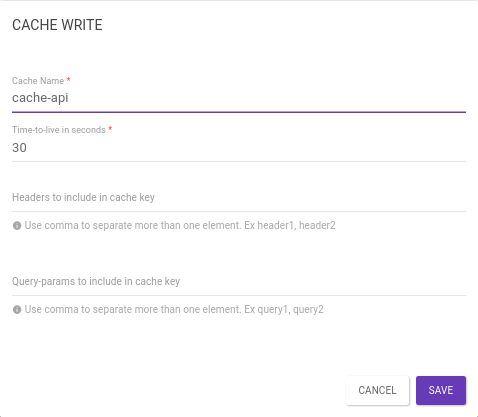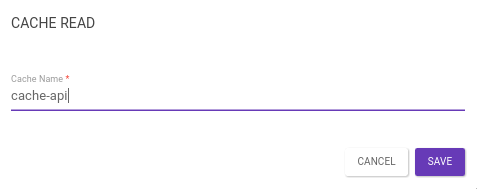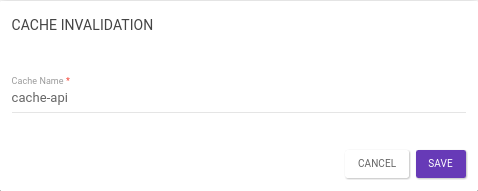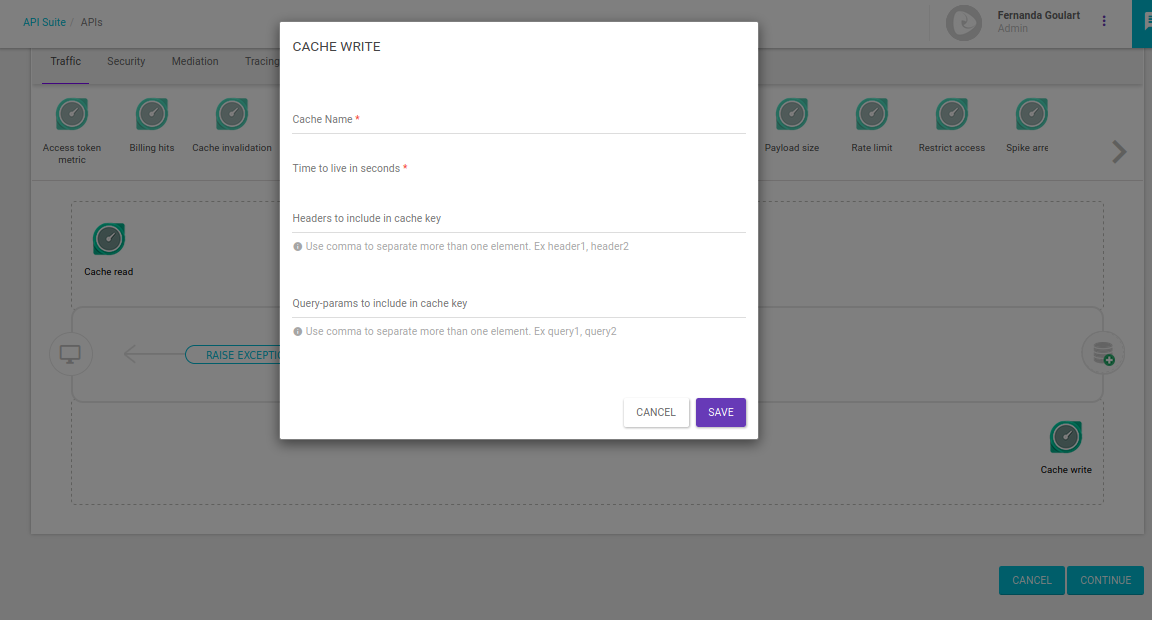Cache
Caching
The caching technique consists of temporarily storing data in a more efficient component to speed up access to information. Then, each time some data are requested and are present in the cache, the latency when accessing it is extremely low.
In situations of high demand, with a large volume of requests, the use of caching brings substantial gains in terms of performance. The API Manager implements caching functionality for any operation of an API.
How can I generate and clear the cache?
Interceptors are in charge of controlling cache usage in responses to API requests.
To create a cache and use it in calls, it is necessary to use a pair of interceptors: o Cache Write is used to create the cache and Cache Read is used to get stored responses from the cache that was created. In order to clear the cache, you can use the Cache Invalidation interceptor.
Let’s understand how each stage works.
First of all, keep in mind that cached responses are configured at the level of operations. Thus, if you’re editing the flow of an API and you can’t find any cache interceptors, check the field Operations, above the flow depiction. If you selected the option "All", the cache interceptors will not be displayed. In that case, select a specific operation to view the interceptors and, if desired, drag them into the flow.
To cache a response, the Cache Write interceptor must be inserted into the response flow of an operation. If the request is successful, the Manager will create a cache based on the configurations entered. For the system to use the response stored in memory, you must include the Cache Read interceptor in the operation’s request flow. Note that the "Cache Name" you configure must be the same for both interceptors.
To delete the response stored in memory, insert the Cache Invalidation interceptor into the request or response flow of an operation, with the "Cache Name" configured as in the Cache Write and Cache Read interceptors.
To clear the entire cache (as well as control the cache volume), go to (the page only appears if your user has the "Cache Control" permission — by default, only Super Admins have it). See more about cache control here.
| In cases where the response is handled by a Custom Interceptor, it’s necessary to use another Custom Interceptor to interrupt the flow when the Cache Read is populated. This prevents cache treatment error from occurring. The interceptor that will interrupt the flow must be inserted in any position after the Cache Read interceptor. |
Cache Write and Cache Read Interceptors
The Cache Write interceptor, when inserted into the response flow of a particular operation, will create a cache based on the settings informed. As of the second request, the system will use the response stored in the memory. To enable this, add a Cache Read interceptor in the request flow:

When the caching is configured, header and/or URL attributes can be included to determine the cache entry that should be used, in addition to, of course, the expiration time of the cached data (time-to-live).

The Cache Read interceptor is responsible for identifying an existing cache by the Cache Name informed. When a request is sent to a cached operation, the interceptor identifies the cache and inserts the in-memory response into the call. This means a performance gain, since the request doesn’t have to be sent to the backend.

| The cache name must be the same as in the Cache Write interceptor. |
Cache Invalidation Interceptor
The Cache Invalidation interceptor is responsible for invalidating a given cache, based on the Cache Name informed. When inserted into a particular operation, the system will find and delete the cache.

Cache Key
Responses from cache data don’t have to be always the same, they can vary depending on pre-defined elements. The cache key identifies the different responses stored. All elements of the request \(URL, headers, query params, etc\) which influence the response must be part of the key. Elements that don’t influence the response can be left out.
| The URL is always part of the key. |
-
If the response to a call can be globally reused — as a list of cities, for example — then the URL is enough as a key. This means that after the first access to, e.g.,
GET /cities, all other accesses, even by other apps or users, will receive the same response from the cache. -
If the URL is the same, but the response is different depending on the user or app used \(for example,
GET/preferencesreturns different data depending on the user involved in the call\), then that user/app needs to be part of the key. -
Other information that influences the response, such as query params used for filtering (e.g.,
GET/products?orderBy=datevs .GET /products?orderBy=price) also need to be part of the key. -
Paging parameters are also candidates to be part of the key (e.g.,
GET /products?page=1vs.GET /products?page=2).
To inform how the cache key should be formed, the administrator must fill out two fields, after selecting the Cache Write interceptor in the response flow:

-
The Headers to include in cache key field should be a comma-separated list of HTTP headers that should be used to compose the key. E.g.: the value
client_id, access_tokencauses theclient_idandaccess\_tokenheaders to be part of the key. -
The Query-params to include in cache key works like the field above, but specifies query params to be added. In the examples above, the cache key would take into account the query params
orderBy,page.
Sub-Resources
When fetching the cache for existing responses, the Gateway will only consider URLs that are exactly the same as requested.
This means that a rule that configures the cache of the resource /products does not set the cache of the resource /products/{id}; indeed, for the API, both of them are two completely separate resources.
Please note, however, that if a caching rule is created for the resource /products/{id}, then the Gateway will cache different responses to /products/123 and /products/456, as expected.
This means that popular products will often be served from the cache, while less viewed products will not be in the cache and will be routed directly to the backend.
The rules above about headers and query params that are part of the cache are also taken into account for resources, such as /products/{id}.
Time-To-Live
Each cache rule specifies a length of time in which the cache is considered valid. After this time, the responses in this cache are discarded. Please note that the values are in seconds; typically, API response caches can last from a few seconds to a few hours, no more than this.
Maximum size
Internally, the gateway has a practical limit to the amount of bytes it can store in memory. The purpose of this is to protect the gateway’s own infrastructure, so that too large a response will not occupy the memory for too long. In general, this limit is large enough to accommodate many reasonable-sized calls; but if the threshold is reached, new responses will only be stored after some are removed.
Cache Update
The cache is update when its time-to-live expires and a request is made for an operation that has the Cache Write and Cache Read interceptors in its flow. To disable a cache, insert a Cache Invalidation interceptor with the same cache name into an operation.
Share your suggestions with us!
Click here and then [+ Submit idea]